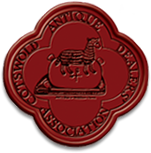Coade Stone
 Two myths are associated with Coade
stone, namely the recipe to manufacture the stone is a secret, and that the the first
Mrs Coade who started the company was married however her daughter who carried on the
business was bestowed the title as was befitting a business woman in Georgian England.
Two myths are associated with Coade
stone, namely the recipe to manufacture the stone is a secret, and that the the first
Mrs Coade who started the company was married however her daughter who carried on the
business was bestowed the title as was befitting a business woman in Georgian England.
Coade started business in 1769 with Eleanor Coade the Elder and an artificial stone manufacturer named Daniel Pincot. This partnership however, was soon dissolved, one of Pincot’s proclamations stated that the Great Wall of China was made of Coade stone! In 1771 a fellow nonconformist dissenter and master sculptor, John Bacon, joined the company as sculptor and manager. It was his masterly craftsmanship that et the company on its way with a number of models that competed with the best sculptures of the day. His death and that of the Elder Mrs Coade in 1799 did not prevent the building of a display gallery in Lambeth and a new partnership between the young Miss Eleanor Coade and her cousin John Sealy. At this time the stamp changed from Coade to Coade Sealy, although I have seen variations such as Coade Lambeth and Coade Lythodipyra (stone twice fired) among others.
The Coade-Bacon and Coade-Sealy periods are considered to be the company’s most productive times, with royal patronage and Royal Acadamian artists such as Thomas Banks, John Flaxman and Benjamin West all working to supply models for statues, ornament, capitols, coats of arms and even gravestones, predominantly in the Neoclassical style, although following fashion Gothic and Egyptian styles were also produced.
In fact any style which could be carved in stone was made in Coade stone and was used extensively by the famed architects of the day such as Robert Adam, John Nash and John Soane.
Back to the myth of manufacturing Coade stone. In the first instance a model, say of a statue, was made in clay to a larger size than required. This allowed for shrinkage in both drying and firing, approximately one inch to every foot. A plaster mould was made of the original model, this mould was then removed in sections and reassembled. The famed Coade clay mix was then pressed into the mould by hand to a thickness of around four inches. The plaster mould was removed and the model was reworked. After curing the model was fired at high temperature in kilns up to 10ft high inside, that, even with today’s technology, would have been hard to manage. At this stage works could have been lost and at worst an exploding model could destroy all the pieces in the kiln.
But what made Coade stone so hard wearing? It comes back to lythodipyra, or stone twice fired. In the Coade mix was clay, from Eleanor’s childhood home of Lyme Regis Dorset; mixed with this were a fine ground grog of pre-fired clay, ?int, sand and ground glass. This mixture, when fired at high temperature, becomes a hard weather impervious ceramic which has in most cases lasted somewhat better than its more expensive competitor stone.
The death of John Sealy saw Mrs Coade handing over slowly to a distant relation, William Croggan, Coade continuing after her death in 1821 in the Croggan line until the moulds were eventually sold in 1840.









